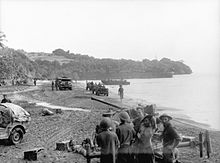6°29′S 147°51′E / 6.483°S 147.850°E
| Landing at Scarlet Beach | |||||||
|---|---|---|---|---|---|---|---|
| Part of the Pacific theatre of the Second World War | |||||||
 Australian soldiers and U.S. Army landing craft at Scarlet Beach on 22 September 1943. A Landing Ship Tank of the VII Amphibious Force unloads in the background. | |||||||
| |||||||
| Belligerents | |||||||
|
|
| ||||||
| Commanders and leaders | |||||||
|
|
| ||||||
| Units involved | |||||||
| |||||||
| Strength | |||||||
| 5,300 | 5,000 | ||||||
The Landing at Scarlet Beach (Operation Diminish) (22 September 1943) took place in New Guinea during the Huon Peninsula campaign of the Second World War, involving forces from Australia, the United States and Japan. Allied forces landed at Scarlet Beach, north of Siki Cove and south of the Song River, to the east of Katika and about 10 kilometres (6.2 mi) north of Finschhafen. The capture of Finschhafen allowed the construction of air base and naval facilities to assist Allied air and naval forces to conduct operations against Japanese bases in New Guinea and New Britain.
After Lae had fallen sooner than the Allies had anticipated, they exploited the advantage. As a result of faulty intelligence, which underestimated the size of the Japanese force in the area, the assault force chosen consisted of only Brigadier Victor Windeyer's 20th Infantry Brigade. The landing at Scarlet Beach that took place on 22 September 1943 was the first opposed amphibious landing that Australian forces had made since the Landing at Anzac Cove in the Gallipoli Campaign of 1915. Navigational errors resulted in the troops being landed on the wrong beach, with some of them coming ashore at Siki Cove and taking heavy fire from the strong Japanese defences in pillboxes. After re-organising, the Australians pushed inland. The Japanese put up stiff resistance on the high ground at Katika, but were forced back. By the end of the day, the Australians had secured their objectives. The Japanese launched a retaliatory air raid on the ships of the VII Amphibious Force, but US fighter aircraft defended the convoy and no ships were hit. Continued Japanese air attacks on the beachhead inflicted numerous casualties over the course of the battle.
The next day the Australians commenced their advance south towards the village of Finschhafen, about 5.6 miles (9.0 km) south of the landing beach, with the 2/15th Infantry Battalion leading the way to the Bumi River. The Japanese had established strong defences along the river's southern bank, which the Australians attempted to outflank by sending a force to the west, climbing through steep terrain. Once they had located a suitable place to cross the river, they began wading across but were fired upon by a group of Japanese naval infantry who were positioned on a high feature overlooking the river. Despite taking casualties, the Australians were able to establish themselves south of the Bumi and at that point the 2/13th Infantry Battalion began to advance on Finschhafen from the west. Meanwhile, the 2/15th attacked the left flank of the Japanese that had opposed their crossing. After advancing up the steep slope under fire, sometimes on their hands and knees, the 2/15th took the position at the point of the bayonet, killing 52 Japanese in close combat.
Australian fears of a Japanese counter-attack grew and they requested reinforcements from General Douglas MacArthur. The request was denied as his intelligence staff believed that there were only 350 Japanese in the vicinity. Actually, there were already 5,000 Japanese around Sattelberg and Finschhafen. The Australians received some reinforcements in the shape of the 2/43rd Infantry Battalion. The arrival of this unit meant that the entire 20th Infantry Brigade could concentrate on Finschhafen. The Japanese naval troops which were holding Finschhafen began to withdraw and Finschhafen fell to the Australians on 2 October. The 20th Infantry Brigade then linked up with the 22nd Infantry Battalion, a Militia infantry battalion that had cleared the coastal area in the south of the Huon Peninsula, advancing from Lae over the mountains. The Japanese withdrew into the mountains around Sattelberg.
© MMXXIII Rich X Search. We shall prevail. All rights reserved. Rich X Search
